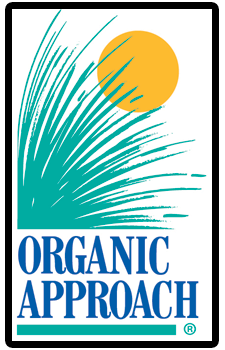- Plant Soil Heath
- 717-299-2112
- info@organicapproach.com
- Organic Approach Website
Bacterial Leaf Scorch – there is no Silver Bullet…
How an Organic Lawn Program will Benefit your Trees
April 13, 2021Cicada mania in Pennsylvania
July 19, 2021Bacterial leaf scorch has become public enemy number one for me in my fieldwork over the last few years. In plant health care issues crop frequently. Whether fungal, viral, bacterial, cultural or pest related, I deal with a number of stressors and challenges in varied environments and hosts on a daily basis. Every once in a while, a more sinister challenge rears its head, and Bacterial Leaf Scorch is such a beast. By way of field experience and individual research I’ve collected a general working knowledge of this disease, the challenges it brings forth, and the best ways I know how to deal with it. I would like to take the opportunity to share these meanderings in case they are of any value to the trees and the people that care for them.
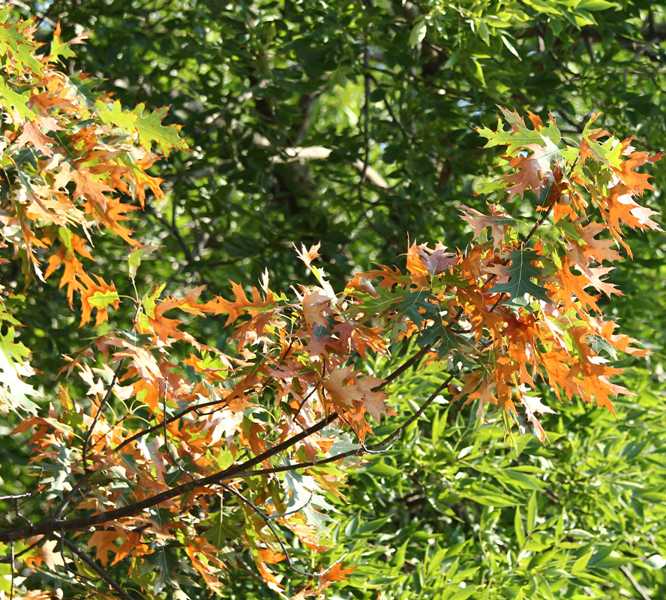
Bacterial Leaf Scorch – Photo Credit: University of Illinois Plant Clinic
Bacterial leaf scorch is caused by a small gram negative bacterium Xyllela fastidiosa. The pathogen is vectored to trees by a variety of planthoppers and treehoppers which may acquire the pathogen from another afflicted tree or from other symptomless hosts in the environment. Bacterial colonies form and grow in mass within the vascular tissue of the tree over time. As the disease spreads throughout the tree, the bacterial colonies occlude the vascular tissue of the tree enough to hinder or completely disrupt the flow of water and nutrients between the roots and canopy of the host, just as a blood clot would in a vein or artery.
The disease symptoms in the foliage express as a marginal leaf burn, starting at the edges and proceeding toward the center of the leaf. This is a result of drought stress due to disrupted vascular transport, usually showing first in midsummer once temperatures heat up and the bacterial colonies have had time to mature throughout the growing season. Scorched leaves will drop earlier than they otherwise would have, which shortens the growing season for the tree and therefore also the amount of food that it is able to produce for itself via photosynthesis. Branches that have been suffering for multiple seasons will die and drop, and eventually the tree will become so thin, stressed, and malnourished that it will succumb to this chronic and fatal disease.
Many different trees can get bacterial leaf scorch as the pathogen is fairly unselective as per its host, but there are some usual suspects. In Lancaster County all of the trees that I am currently treating for BLS are Oaks, with Pin and Red seeming exceptionally susceptible. I have also read of BLS cropping up in sycamore, Red maple, Sweetgum, American elm, and even honeylocust (which is very challenging to identify scorch in because of the compound leaf).
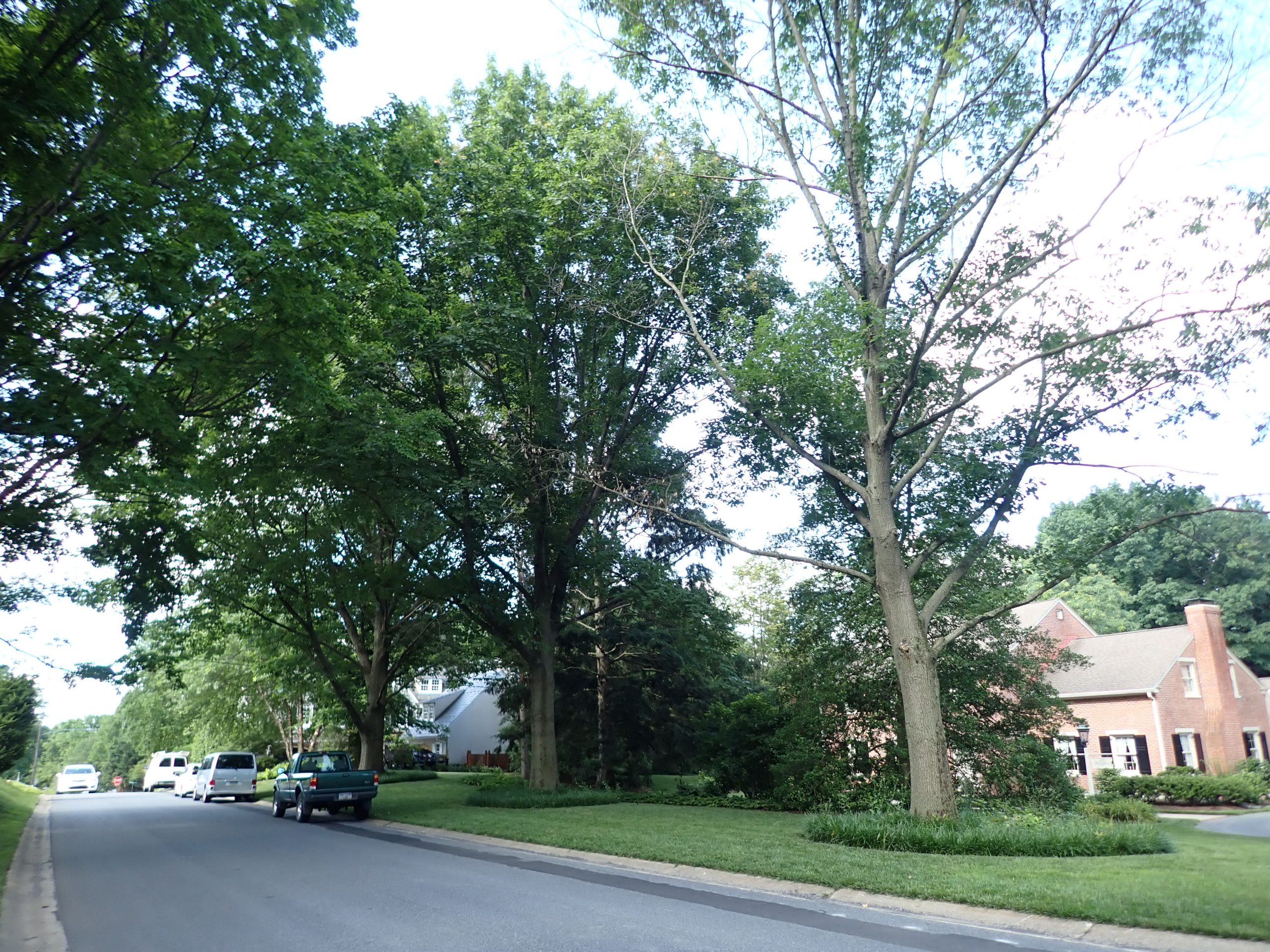
The progression of bacterial leaf scorch in 3 Red oaks that contracted the disease sequentially over numerous seasons down the row from North to South… This photo was taken in June prior to onset of seasonal scorch symptoms to clearly show past damage.
As of now there is no known cure for bacterial leaf scorch and the prognosis is bleak. The conventional wisdom states that you should prune the dead wood and scraggly water sprouts out of your tree to keep it pretty, and mulch and water your tree to keep it as happy and healthy as possible until it’s ultimate demise. I think we can do more, so I’ve been treating these trees my own way. I use a multi-faceted approach consisting of stress reducers, soil builders, fertilizations, antibiotic injections, and sound cultural practice. I do not know if I will ever be able to “save” a tree by curing bacterial leaf scorch, but I do know that I have been seeing success in the field over the last few seasons, and that gives me hope. Here follows my bacterial leaf scorch regimen, the goal of which is “reduce stress, retain as many leaves as possible, push more leaves the following season, repeat.
- Early ID of pathogen and stress
- Cultural
- Remove grass, groundcover. Expand bed, topdress with organic soil builders and leaf compost
- Water tree during summer drought stress infrequently and deeply
- Avoid pruning anything but dead wood
- Chemical control
- Once a year antibiotic trunk injection to suppress symptoms
- Stay on top of insect stress and residual pest populations
- Organic stress reducers/biostimulants/fertilization
- Spring stress reducer soil injection
- Summer stress reducer/compost tea soil injection
- Fall deep root feed soil injection
Early Identification is critical to having any kind of chance with bacterial leaf scorch. Recurring growing seasons with the disease leads to compound damages, and some trees will be too far gone to be treated at all. When the visual symptom of marginal leaf burn shows up even slightly (look from July-September), it’s time to collect some leaves and send tissue samples to a lab. Even without a positive ID, the cultural and organic practices in my program can be implemented at any time to negate plant stress, and healthy plants are more disease resistant. An ounce of prevention is worth a pound of cure, and so forth…
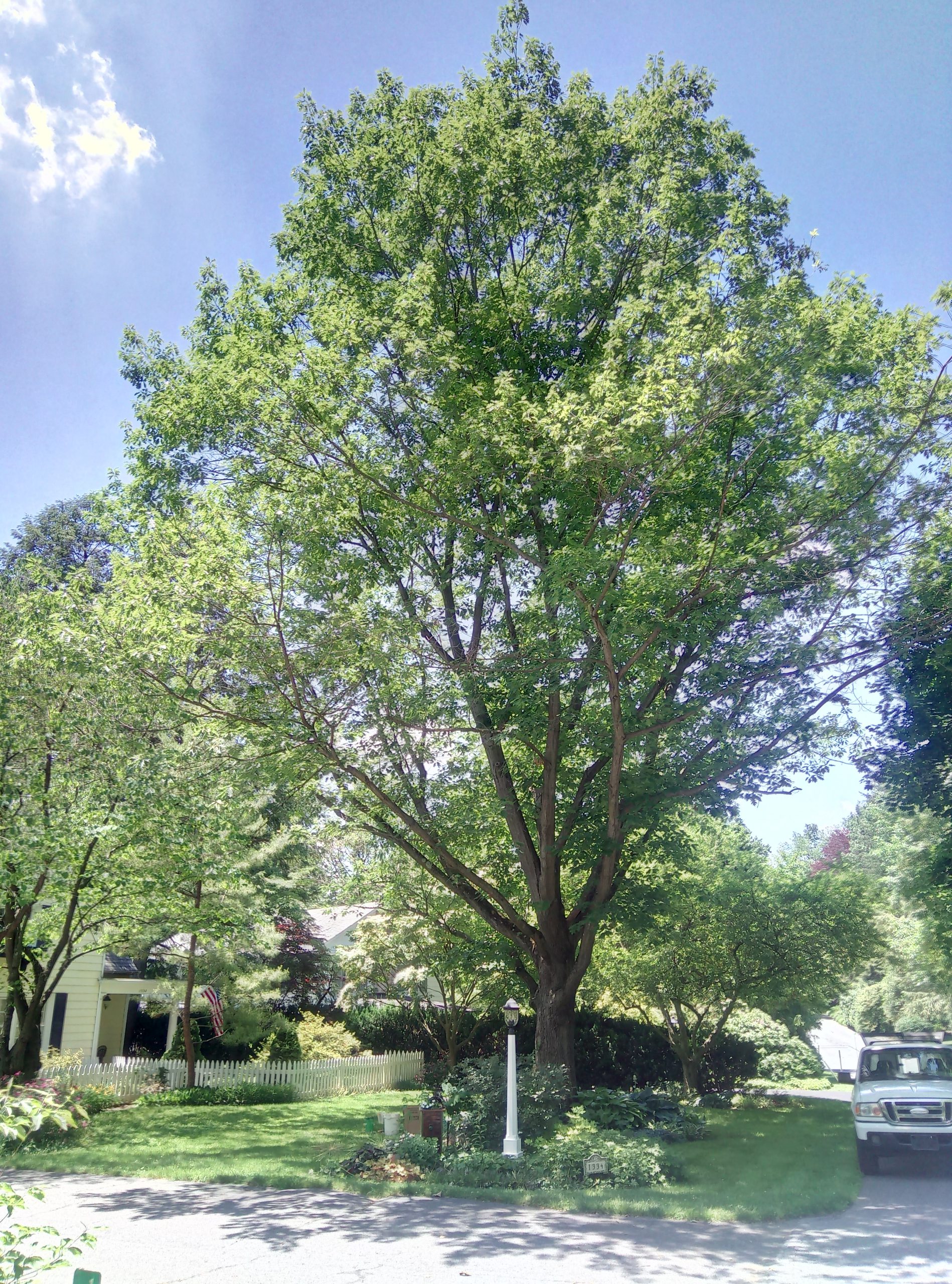
A rare BLS patient oak that has been hanging on for over a decade against the odds (this photo was alo taken in June). This tree has had both organic stress reducer treatments and an oxytetracycline application in the past, but nothing since roughly 2009 until this spring (treatment gap of at least a decade)- a testament to sound cultural practices and good soil… still plenty of room for improvement..
Good cultural practices can be completed by any homeowner on their own property, or with the help of a good landscape technician. Grass under sick trees, or trees in general, is really no good. Turf competes with trees in shared root space for water and nutrients, so in such a competitive environment, less resources will be available to the tree. The tree’s roots may also suffer from soil compaction from heavy lawnmowers, as well as the regular applications of herbicides, grub controls, and synthetic nitrogen that are popular in general lawn programs.
Remove the grass around the trunk and replace it with a bed- at least 10-15’ diameter, but the bigger the better. Replace the grass with a topdress of mulch, or much better yet- leaf compost! Leaf compost does a better job of recreating the forest floor by providing a more suitable source of carbon to feed the biology. If you want to go the extra mile, put down Finesse GVH or Carbo-Grow 3-0-3 first before top dressing with leaf compost. Finesse GVH can also be applied in the fall at the screaming rate of 100lbs/ thousand sq. ft. as a powerful soil builder. These products will get the biology churning and start building better soil over the tree’s roots quickly. More biology and better soil means less compaction, greater water retention, and better stress resistance across the board.
Another good cultural step for taking care of a BLS patient is to water the tree during the growing season – the right way! There is a right and a wrong way to water a tree suffering from drought stress. If you water shallow and frequently, you will train the tree’s roots up toward the surface. This is called hydrotropism – do not do this. Wait until the spring rains have passed and it is hot and dry, then water for one to two hours every 10-14 days with a garden hose on low pressure directly at the base of the tree. This deep watering practice trains roots down, where they will have greater access to groundwater and nutrition when drought conditions do arise. Water in the morning. Watering at night encourages disease.
Pruning decisions in leaf scorch patients come down to circumstance for me. Certainly remove dangerous dead wood or badly compromised limbs that may prove a liability. When it comes to questionable limbs and water sprouts though, I recommend letting lying dogs lie. Pruning cuts to living tissue are wounds and therefore add stress to an already stressed tree, and they also open an entry point for other pathogens and pests. I also think that it is important to keep as many leaves as possible on a tree with bacterial leaf scorch, unless the pathogen is almost certainly isolated in a very specific part of the tree and can be safely removed.
Certain chemical control methods have proven beneficial in bacterial leaf scorch management. One such method that I rely on heavily is a trunk injection of the antibiotic oxytetracycline. This antibiotic treatment when done in late spring before the end of June does seem to suppress the visual scorch symptoms of the tree during the same growing season and subsequently improve the foliage retention rate and duration going into the same fall. It should be repeated that the antibiotic does not eradicate the pathogen from the tree, but suppress the symptoms for one growing season. This is not a silver bullet, but I believe it to be a valuable tool in the toolbox. I have two reservations regarding this method- first, the procedure to administer the antibiotic physically wounds the tree because the applicator must tap directly into the trunk (but it doesn’t do nearly as much damage as the disease itself), and secondly, I imagine that pushing a highly concentrated antibiotic directly into the vascular tissue of a mature shade tree would potentially wipe out a lot of beneficial biology as well. More on this later…
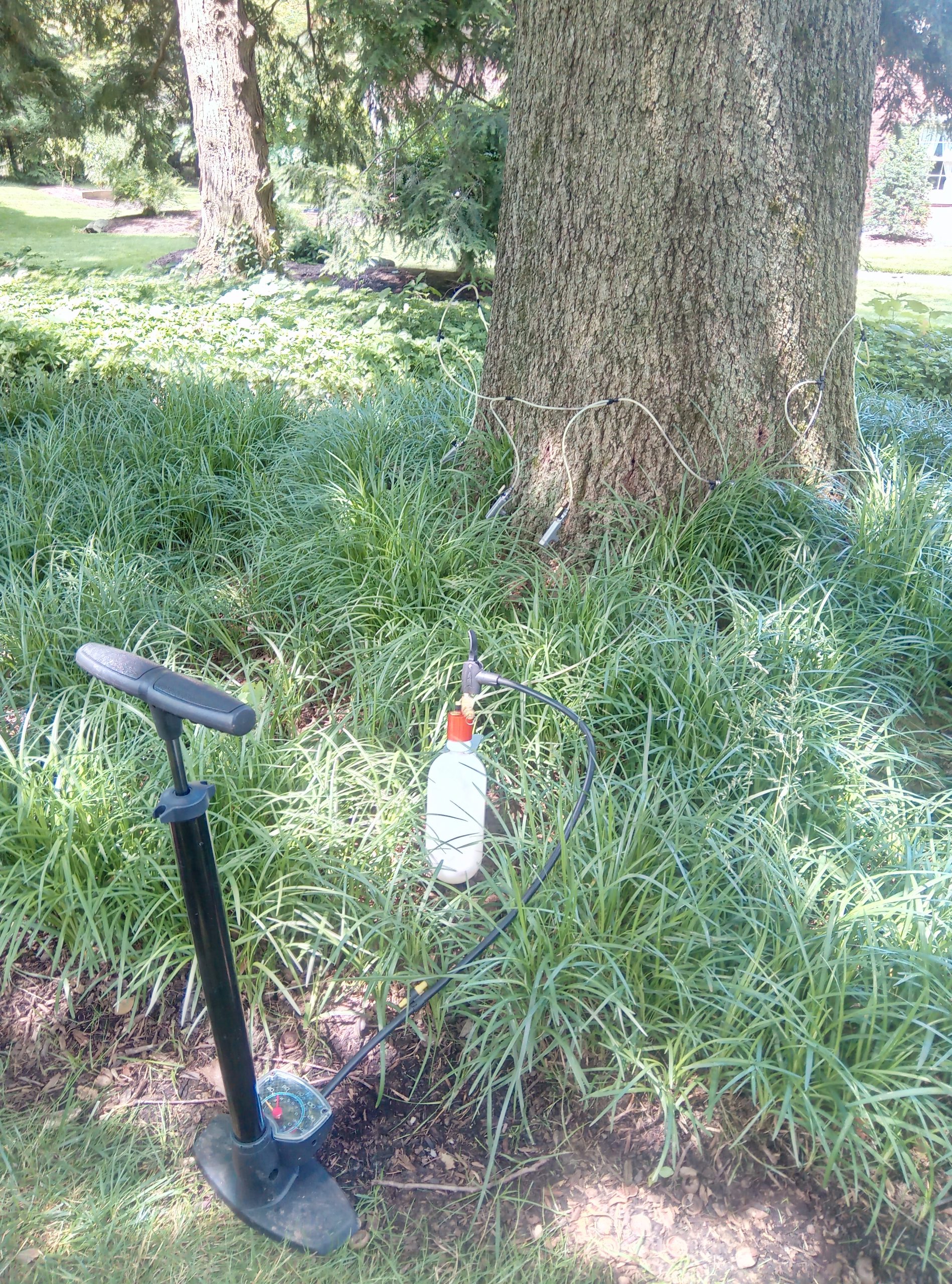
Annual spring application of oxytetracycline for seasonal scorch symptom suppression
Another important step in the disease management of BLS is to suppress other stressors in the environment as well, including insect pressure. Strategic insecticide applications can be made to reduce defoliation from feeding damage and additional potential defoliation. All chemical control should be completed at the discretion of a certified applicator.
Lastly, applications of organic and biostimulatant materials are my bread and butter, and I believe them to be a critical missing link in the disease management cycle of BLS. The more beneficial biology you have in the environment, the less disease occurrence you will encounter. The good biology, when well established, will compete with the bad biology and displace it to some degree. If I am going to prescribe a course of antibiotics, then it would be prudent to prescribe a follow up course of probiotics to reestablish the beneficial flora in the system. This restoration of natural balance to systems is what gives trees the capacity to ramp up their own defense mechanisms. If I combine this biological approach with balanced organic fertility components, then I can reduce environmental stress and disease pressure while simultaneously pushing new growth to replace lost foliage from previous scorch seasons.
I already touched a bit on biological soil builders when I referenced the layering of our granular products beneath leaf compost in the cultural section of these protocols. Now we are going to address the liquid side of my organic tree practice. Three times a year, spring, summer and fall, I offer high volume soil injections to my tree service clients. A mature Oak tree on my program will receive three 50 gallon soil injection applications a year. The rates and composition of each application mix change some to address a specific set of seasonal challenges, but in general they are all composed of the same backbone products: Influence/Nourish, LC 10+7, etc. An expansion on my soil injection techniques and materials can be found in a past blog, Radical Root Run, here: (https://www.plantsoilhealth.com/radical-root-run/). I will sometimes throw in a drench with compost tea as well for good measure, and apply a heavy rate of Finesse GVH in the fall under the dripline.
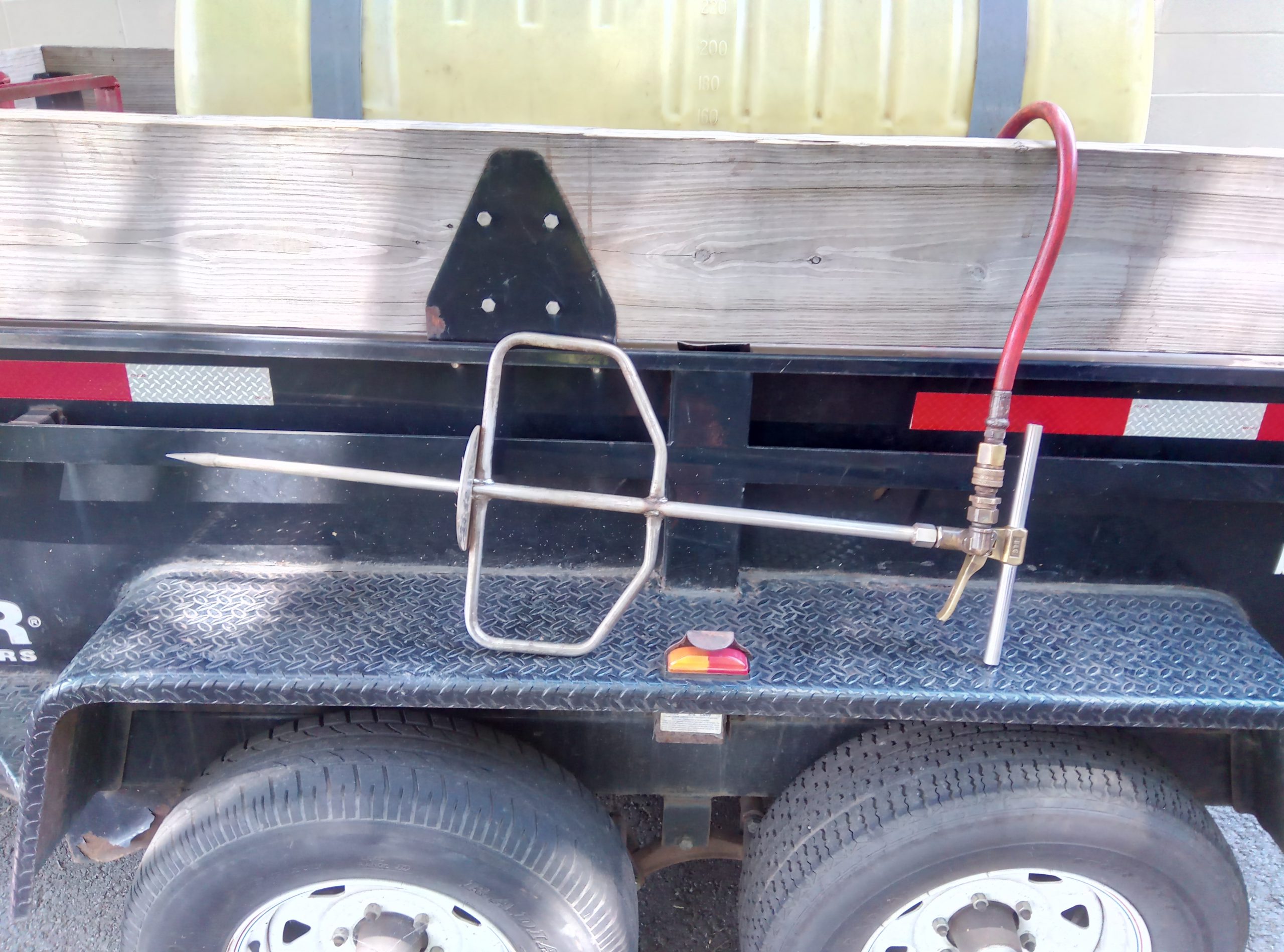
The injector that I use for high volume liquid soil injection stress reducer and deep root feed applications. A mature oak tree will receive 3 injections of roughly 50 gallons each annually.
In conclusion, let’s return to the action items from the first page: “reduce stress, retain as many leaves as possible, push more leaves the following season, repeat. The reason that these trees ultimately die of a slow burn is that they cannot produce the amount of food and energy that they need to support their structure over time. Every season, trees mine water and nutrition from the soil, and send these raw resources from the roots to the shoots where the leaves create food in the form of carbohydrate sugars via photosynthesis. This food is distributed through the tree for growth and some of it is returned to the roots to be stored as reserve energy for future growth. Bacterial leaf scorch completely hijacks this most basic life process of trees. Bacterial colonies disrupt vascular flow, resulting in water stress and nutritional deficiency in the canopy, leaf tissue dies and drops, photosynthesis is slowed, branches die and drop, and the tree becomes less and less productive over consecutive seasons until it finally fails completely.
With good cultural practice, we give trees a fighting chance in a competitive environment and we improve challenged soils. With antibiotic injections, we suppress leaf scorch symptoms enough that a struggling tree can get it’s head above water long enough to take a breath. With Organic biostimulants, we harness the power of microbiology to join the good fight in disease resistance, and we also make an effort to replace the beneficial biology that may have been suppressed by the antibiotics. With organic fertility components, we help the tree put on vigorous growth to replace the tissue that it has lost.
Every single leaf on a tree is a site for photosynthesis and transpiration, therefore every single leaf is valuable to a tree with a compromised vascular system. By retaining existing leaves and putting on additional ones, we facilitate the trees ability to produce energy for future growth. By suppressing the disease pathogen during the growing season, we clear the path for that growth. Vigorous trees put on new vascular tissue every year just under the bark. Old living tissue dies, and becomes structural wood. It is my hope that if the multifaceted pressure of this program is kept up for enough consecutive growing seasons, the scars of bacterial leaf scorch may become compartmentalized in the heartwood of some of these trees like a distant memory, and we may be able to watch them outgrow it.
-Josh Morgan
6/15/2021
